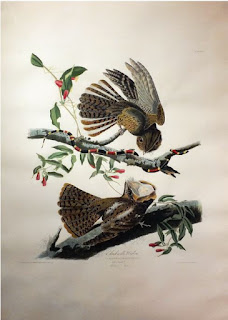Please Contact the gallery if you have questions about the bidding process, or need further information about a particular lot. Our gallery associates are quick to respond to your needs and will help ensure a successful auction outcome. We are driven to perfect and grow your collection, and provide you with the tools necessary to do so.
Highlight of the Week: Lot 12
Chuck-Will's Widow, Plate 52
37 x 49" framed
Once Audubon had committed to his project, producing
the monumental Birds of America, it fell to him to find an engraver and
subscribers. After a failed attempt to drum up interest in Philadelphia ,
he turned to Europe . Departing from New Orleans in 1826, he arrived in Liverpool
first. While in Europe , he presented himself
as a romanticized American woodsman. He dressed in buckskins and applied bear
grease to his long hair, playing to the English’s attraction to characters of
frontier culture. He brought more than 300 pictures, which were exhibited in
Liverpool, Manchester , and Edinburgh Edinburgh
In London America
Audubon’s prints are, in a word, stunning. He was an
exceptional naturalist. The striking posture of the birds displays as much of
their shape and plumage as possible, with a degree of detail that proves the
extent of his research. Audubon stood out from other ornithological naturalists
of his time by depicting his birds in dynamic, active attitudes, rather than
just in profile. The artist’s eye and hand can be seen on every page; the birds
have personalities, and with them, Audubon cemented his status as an American
archetype, as much a part of our national folklore as George Washington or
Johnny Appleseed.













No comments:
Post a Comment